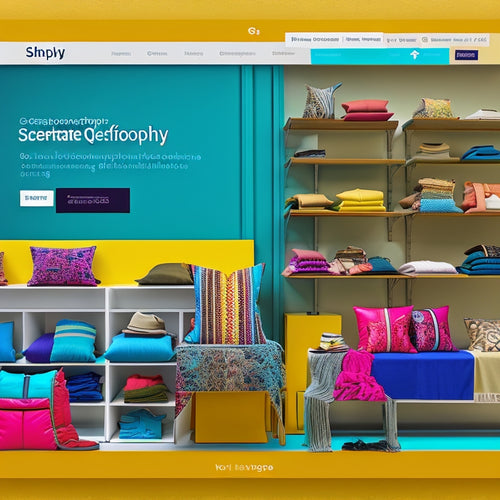
Enhance Ecommerce Customer Experience With Digital Solutions
Share
You can enhance your ecommerce customer experience by identifying pain points in the customer journey, providing 24/7 support with AI-powered chatbots, and streamlining order fulfillment and shipping. Personalizing product recommendations with advanced algorithms and implementing omnichannel engagement strategies can also drive loyalty and revenue growth. By leveraging digital solutions, you can optimize processes, improve communication, and create customized experiences that boost sales and satisfaction. As you explore these strategies, you'll uncover even more opportunities to refine your approach and take your customer experience to the next level.
Key Takeaways
• Implement AI-powered chatbots to provide 24/7 customer support, reducing response times and increasing customer satisfaction.
• Optimize the checkout process with mobile optimization, secure payment gateways, and personalized recommendations for a seamless experience.
• Leverage social media to engage with customers in real-time, showcase products, and gather feedback to build a loyal community.
• Analyze customer behavior with data analytics to predict buying habits, improve marketing strategies, and enhance personalized experiences.
• Streamline order fulfillment and shipping with automated processing, real-time tracking, and timely updates to minimize costs and increase satisfaction.
Identify Pain Points in Customer Journey
You can greatly enhance ecommerce customer experience by pinpointing and addressing the specific pain points that occur at each stage of the customer journey, from awareness to post-purchase support. By doing so, you'll identify areas where customers struggle, get frustrated, or abandon their purchases.
For instance, you might find that your website's search function is inefficient, leading to high bounce rates. Or, that your checkout process is too lengthy, causing cart abandonment. To tackle these issues, you can improve customer communication by implementing a robust FAQ section, providing clear product information, and offering multichannel support.
Additionally, optimizing your checkout process can significantly reduce friction. Consider streamlining your checkout flow, offering guest checkout options, and providing real-time shipping estimates. By addressing these pain points, you'll create a seamless, customer-centric experience that drives loyalty, retention, and ultimately, revenue growth.
Leverage AI-Powered Chatbots for Support
By integrating AI-powered chatbots into your ecommerce platform, you can provide 24/7 customer support, slashing response times and dramatically reducing the workload of human customer support agents. This allows you to allocate resources more efficiently, focusing on complex issues that require human intervention.
AI-powered chatbots can handle routine inquiries, freeing up your support team to tackle more strategic tasks. Additionally, chatbots can improve communication by providing instant responses to customer queries, reducing frustration and anxiety. They can also help increase efficiency by automating repetitive tasks, such as answering frequently asked questions or helping customers track their orders.
By leveraging AI-powered chatbots, you can create a seamless customer experience, driving loyalty and retention. Furthermore, chatbots can provide valuable insights into customer behavior, helping you identify areas for improvement and optimize your customer support strategy.
Streamline Order Fulfillment and Shipping
Optimizing order fulfillment and shipping processes is essential for ecommerce businesses, as it directly impacts customer satisfaction, loyalty, and ultimately, revenue growth.
You can't afford to have inefficient logistics, as it leads to delayed shipments, increased costs, and a loss of customer trust.
To avoid this, you need to implement automated processing and real-time tracking. This allows you to streamline your order fulfillment process, reducing errors and increasing the speed of delivery.
With automated processing, you can allocate resources more efficiently, ensuring that orders are fulfilled promptly and accurately. Real-time tracking enables you to keep customers informed about the status of their orders, reducing anxiety and building trust.
By leveraging efficient logistics and cost-effective solutions, you can minimize shipping costs, reduce delivery times, and increase customer satisfaction.
Personalize Product Recommendations
Effective ecommerce companies utilize advanced algorithms and machine learning to analyze customer behavior and preferences, generating personalized product suggestions that resonate with individual shoppers. By doing so, you can create a customized experience that directly addresses each customer's needs and interests. This is achieved through dynamic customization, where interactive interfaces adjust to user interactions, offering relevant recommendations in real-time.
To take it a step further, you can integrate targeted promotions that align with user preferences. This approach guarantees that customers receive offers that are relevant to them, increasing the chance of conversion. By leveraging machine learning, you can identify patterns in customer behavior, recognizing opportunities to upsell or cross-sell related products. This not only enhances the customer experience but also boosts revenue growth.
Implement Omnichannel Engagement Strategies
You can maximize customer engagement by synchronizing your brand's presence across multiple touchpoints, ensuring a cohesive experience that seamlessly shifts between online and offline channels. This omnichannel approach allows you to provide a unified and consistent experience, building trust and loyalty with your customers.
To take your omnichannel engagement to the next level, consider the following strategies:
-
Leverage interactive videos to create immersive experiences that drive engagement and conversions
-
Harness the power of social media engagement by responding promptly to customer inquiries and comments
-
Utilize augmented reality and virtual assistants to provide customers with personalized and interactive experiences that simulate real-life interactions
Enhance Website Search and Filtering
By streamlining your website's search functionality and filtering options, you can empower customers to quickly find what they're looking for, thereby reducing bounce rates and increasing conversions. A well-designed search system allows customers to effortlessly navigate your product catalog, leading to improved navigation and user experience.
To take your search functionality to the next level, consider implementing advanced filtering options such as:
| Filtering Options | Benefits |
|---|---|
| Price Range | Allows customers to narrow down products by price, making it easier to find affordable options |
| Product Features | Enables customers to filter by specific product features, such as color, size, or material |
| Brand | Allows customers to search by specific brands, making it easier to find products from trusted manufacturers |
| Customer Reviews | Enables customers to filter products by customer review ratings, helping them make informed purchasing decisions |
Foster Customer Loyalty Programs
Implementing a well-structured customer loyalty program can significantly increase customer retention, as it rewards repeat customers and encourages repeat business. By doing so, you'll be able to differentiate yourself from competitors and create a loyal customer base that drives long-term growth.
Here are some key strategies to take into account:
-
Tiered loyalty rewards: Offer increasingly exclusive benefits as customers reach specific milestones, such as purchase amounts or frequency.
-
Personalized communication: Use data and analytics to customize your messaging and offers to individual customers, increasing the likelihood of engagement.
-
Omnichannel integration: Ensure your loyalty program is seamlessly integrated across all touchpoints, from website to social media to in-store experiences.
Measure and Analyze Customer Feedback
To further refine your customer loyalty program and identify areas for improvement, gathering and analyzing customer feedback is essential, as it provides actionable insights into their preferences, pain points, and expectations.
You can collect feedback through surveys, reviews, and social media interactions. By leveraging survey insights, you'll uncover patterns and trends that'll help you optimize your customer experience strategy. Sentiment analysis, a technique used to determine the emotional tone behind customer feedback, will also provide valuable information on how customers perceive your brand.
When analyzing feedback, you'll identify strengths and weaknesses in your customer loyalty program. You'll pinpoint areas where you're exceeding customer expectations and where you're falling short. This information will enable you to make data-driven decisions to improve your program, increase customer satisfaction, and drive loyalty.
Frequently Asked Questions
What Is the Ideal Ratio of Human to Chatbot Customer Support?
"Many hands make light work," but when it comes to customer support, you'll find the ideal ratio of human to chatbot is 70:30, as high chatbot performance in initial interactions frees humans to handle complex issues, optimizing customer interaction ratios.
Can Ai-Powered Chatbots Handle Complex Customer Complaints?
You'll find that AI-powered chatbots can efficiently handle routine customer inquiries, but their limitations become apparent when dealing with complex complaints, requiring human empathy and nuance to resolve, compromising customer service efficiency.
How Do I Measure the ROI of Personalized Product Recommendations?
"You're likely aware that 71% of consumers feel frustrated when their shopping experience is impersonal. To measure ROI of personalized product recommendations, you'll need to analyze conversion rates and customer engagement metrics, incorporating user feedback into your data analysis to optimize results."
What Is the Best Way to Integrate Loyalty Programs With Existing Systems?
You'll maximize loyalty program integration by ensuring system compatibility, then focus on rewards optimization to boost customer engagement, leveraging APIs for seamless data exchange and streamlining processes to drive ROI.
Do Customers Prefer Mobile Apps or Mobile Websites for Ecommerce?
You'll find that customers crave convenience, and when it comes to mobile ecommerce, they're split - some favour feature-rich mobile apps for seamless user experience and functionality, while others prefer the flexibility and convenience of mobile websites for effortless engagement.
Related Posts
-

10 Best Online Courses for Merchants to Scale
You're scaling your online store, and you know it's not easy. From ecommerce fundamentals to product visibility and i...
-
Discover the Best Sitemap Apps for Shopify
This article aims to provide an analytical overview of the best sitemap apps available for Shopify, focusing on thei...
-

How Many Product Options Can You Have in Shopify
This article examines the extent to which product options can be utilized in the Shopify platform. It explores the b...

